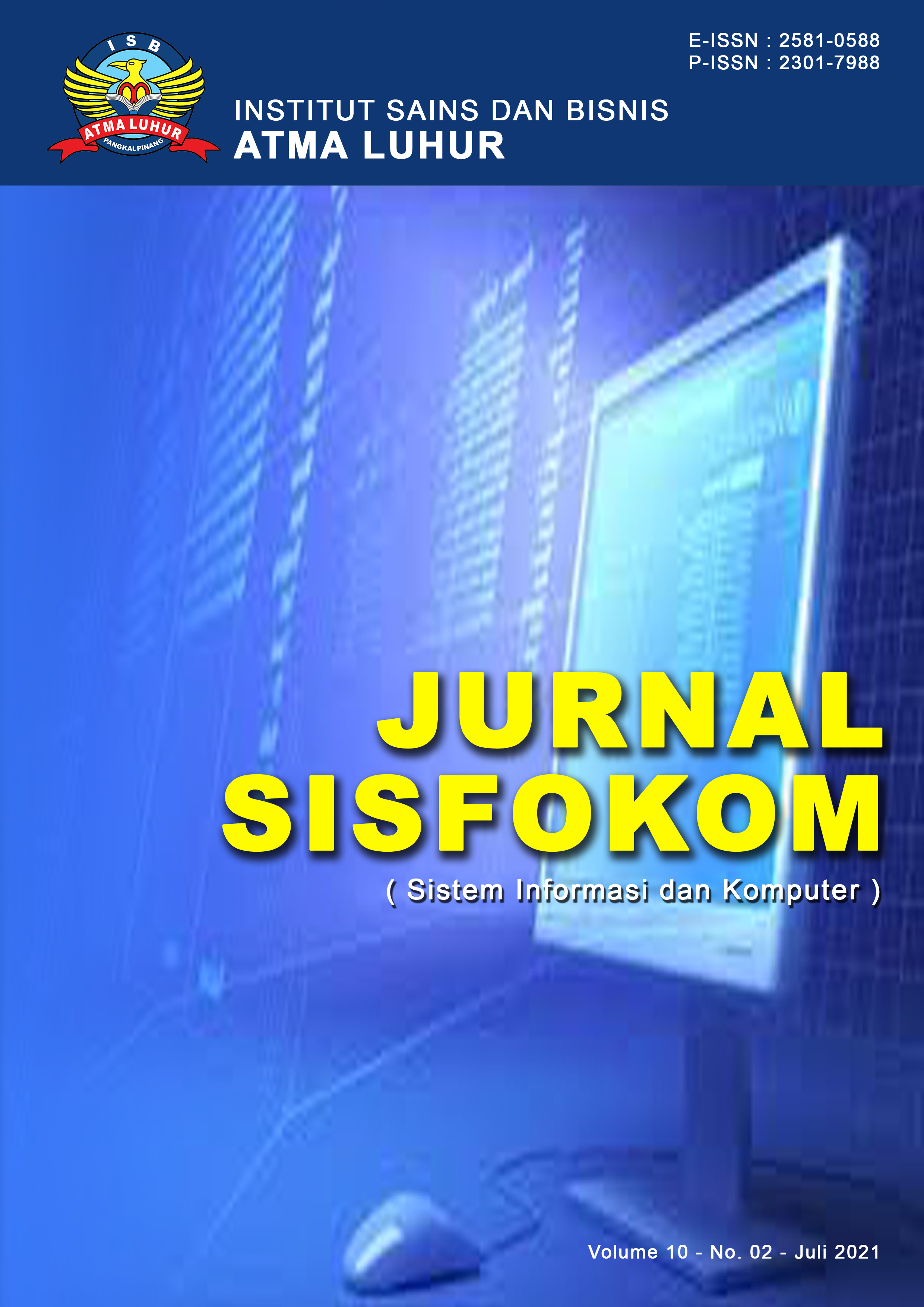Analisis Hubungan Rerata Screen Time Ponsel, Bidang Pekerjaan dengan Rerata Jam Tidur Di Masa Pandemi
DOI:
https://doi.org/10.32736/sisfokom.v10i2.1031Keywords:
teknologi, ponsel pintar, Covid-19, lama tidur, screentimeAbstract
Seiring berkembangnya teknologi yang ada, banyak masyarakat yang menjadikan alat elektronik menjadi kebutuhan sekunder atau bahkan menjadikan sebagai kebutuhan primer. Terbukti bahwa penjualan ponsel pintar pada kuartal pertama tahun 2019 mencapai 370 ribu unit[1]. Tentunya lama waktu screen time untuk tiap orang beda-beda, telebih keadaan saat ini dimana bebrapa persahaan menerapkan sistem work from home. Berdasarkan data yang kami terima dari 46 responden, kami melakukan perbandingan terkait umur, screen time harian, bidang pekerjaan, dan perubahan kebiasaan screen time, kemudian dibandingkan dengan waktu tidur harian dari responden. Pada hubungan umur dengan waktu tidur didapatkan data sebanyak 30,43% responden yang berumur 20-25 tahun menghabiskan waktunya untuk tidur selama 6-8 jam sehari. Lalu hubungan screen time harian dengan waktu tidur didapatkan data bahwa sebanyak 12 responden yang menatap layar selama 3-5 jam sehari, menghabiskan waktunya untuk tidur selama 6-8 jam sehari dengan persentase 26,09%. Selanjutnya hubungan antara bidang pekerjaan dengan waktu tidur, dimana sebanyak 17 responden yang bekerja di bidang teknologi informasi mengabiskan waktu selama 6-8 jam sehari untuk tidur dengan persentase 36,96%. Lalu hubungan antara perubahan kebiasaan screen time dengan waktu tidur dimana terdapat 22 responden yang mengaku bahwasanya mereka lebih sering menatap layar disaat pandemi ini namun masih menghabiskan waktu selama 6-8 jam sehari untuk tidur dengan persentase 47,83%. Dari penelitian ini, dapat disimpulkan bahwa tidak terdapat cukup bukti untuk menyangkal hipotesa tidak terdapat korelasi antara total screen time harian, bidang pekerjaan, perubahan kebiasaan screen time di tengah pandemi terhadap kuantitas waktu tidur.References
“CNBC Indonesia,” CNBC , 06 Juni 2020. [Online]. Available: https://www.cnbcindonesia.com/tech/20200602174956-37-162552/penjualan-samsung-huawei-oppo-anjlok-xiaomi-malah-naik. [Diakses 17 October 2020].
P. Michael B. Robb, “The New Normal: Parents,Teens, Screens, and Sleep in the United States,” Common Sense Media, San Fransisco, 2019.
R. F. L. ,. S. N. Shahibatul Hablain, “HUBUNGAN PENGGUNAAN GADGET DENGAN KUANTITAS DAN KUALITAS TIDUR PADA ANAK SEKOLAH (KELAS IV DAN V),” Jurnal Keperawatan Abdurrab, pp. 26-37, 2020.
N. Perez-Farinos, “The relationship between hours of sleep,screen time and frequency of food anddrink consumption in Spain in the 2011and 2013,” BMC Public Health, 2017.
F. Xu, S. K. A. S. A. Cohen, J. E. Earp dan M. L. Greaney, “Relationship between Physical Activity, Screen Time, and Sleep Quantity and Quality in US Adolescents Aged 16–19,” International Journal of Environmental Research and Public Health, vol. 16, no. 9, 2019.
A. Sigman, “Time for a view on screen time,” Biochemical Medical Journal, 2012.
W. Poerwadarminta, Kamus Umum Bahasa Indonesia, Jakarta: Balai Pustaka, 2002.
H. L. Magee, “Longitudinal assocoations between sleep duration and subsequent,” ELSEVIER Sleep Medicine Reviews, Vol. %1 dari %2231-241, 2012.
N. I. o. Health, Your Guide to Healthy Sleep, United States of America: NH Publication, 2005.
T. Chaput JP, “Insufficient Sleep as a Contributor to Weight Gain : An Update,” Metabolic Health, pp. 245-256, 2012.
H. S. C. Y. W. R. C. L. L. Chang SP, “The Relationship between Sleep Quality and the Exercise Participation Behavior of College Students in the Central,” International Journal of Sport and Exercise Science, pp. 13-18, 2013.
S. C. L. H. H. Y. C. K. C. K. Y. K. Y. Y. Cheng SH, “A study on the sleep quality of incoming university students,” Psychiatry Research, pp. 270-274, 2011.
N. S. Fondation, “Sleep-Wake Cycle: Its Physiology and Impact on Health,” 2006.
A. M. ,. A. R. Anandita Mega Kumala, “HUBUNGAN ANTARA DURASI PENGGUNAAN ALAT ELEKTRONIK (GADGET), AKTIVITAS,” Journal of Nutrition College, pp. 73-80, 2019.
R. Ananta, A. S. Syamsudin, A. Arifuddin dan N. A. Rakhmawati, “Dataset Kuisioner Analisa Penggunaan Ponsel Selama Pandemi,” Zenodo, 2020.
Downloads
Additional Files
Published
Issue
Section
License
The copyright of the article that accepted for publication shall be assigned to Jurnal Sisfokom (Sistem Informasi dan Komputer) and LPPM ISB Atma Luhur as the publisher of the journal. Copyright includes the right to reproduce and deliver the article in all form and media, including reprints, photographs, microfilms, and any other similar reproductions, as well as translations.
Jurnal Sisfokom (Sistem Informasi dan Komputer), LPPM ISB Atma Luhur, and the Editors make every effort to ensure that no wrong or misleading data, opinions or statements be published in the journal. In any way, the contents of the articles and advertisements published in Jurnal Sisfokom (Sistem Informasi dan Komputer) are the sole and exclusive responsibility of their respective authors.
Jurnal Sisfokom (Sistem Informasi dan Komputer) has full publishing rights to the published articles. Authors are allowed to distribute articles that have been published by sharing the link or DOI of the article. Authors are allowed to use their articles for legal purposes deemed necessary without the written permission of the journal with the initial publication notification from the Jurnal Sisfokom (Sistem Informasi dan Komputer).
The Copyright Transfer Form can be downloaded [Copyright Transfer Form Jurnal Sisfokom (Sistem Informasi dan Komputer).
This agreement is to be signed by at least one of the authors who have obtained the assent of the co-author(s). After submission of this agreement signed by the corresponding author, changes of authorship or in the order of the authors listed will not be accepted. The copyright form should be signed originally, and send it to the Editorial in the form of scanned document to sisfokom@atmaluhur.ac.id.









